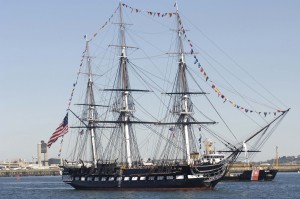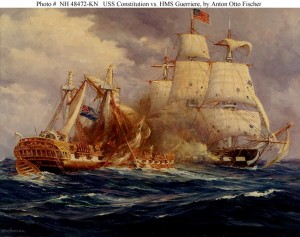Evolution of Naval Armor, Part 1: “Old Ironsides”
(To see all the posts in this series, click here: Naval Armor.)
Battle ship design is a series of trade-offs: heavy armor and armament (and thus great weight) vs. speed given the available room for sails or engines, size (and target profile) vs. maneuverability. The various design compromises – light, fast and maneuverable vs. heavy, slow and powerful are the reason we have such a variety of ships in naval history – patrol/torpedo boats, destroyers, frigates, light cruisers, heavy cruisers, dreadnoughts, and battle ships. During our revolutionary period, the heaviest and most powerfully armed ships were called first-rate ships of the line, meaning that they could hold a place in a battle line of ships and face any opponent. The fledgling United States did not have any ships-of-the-line, but we did produce three heavy frigates: built for more speed and maneuverability, but still fairly heavily armed.
Most everyone has heard of “Old Ironsides”, the oldest commissioned naval vessel in the World. She is properly the USS Constitution, one of three completed (the other two being the USS United States and the USS Constellation) out of the six heavy frigates commissioned by Congress in 1794. Named by President Washington, she was launched in September, 1797. She was one of the nascent Navy’s capital ships – the best our young country could produce.
But did you know that she does not have iron sides? Constitution is sixty-five years ahead of that innovation. She earned her nickname in the War of 1812, in a battle with the HMS Guerriere. As the story goes, a British sailor observed their cannonballs bouncing off the side of the Constitution, and exclaimed “Huzzah! Her sides are made of iron!” The nickname stuck, helped along by an 1830 poem by Oliver Wendell Holmes.Her sides are actually southern live oak, a very dense wood which can weigh 75 pounds per cubic foot. Also, in an age where ships of the line had 18 inch thick sides, the Constitution had 21 inch sides. Of course this made her very heavy, and she actually drove her launch rails into the mud and got stuck at her first launch attempt. However, the heavy oak sides paid off, and she survived 42 battles in her combat career. She still sails – her career continues to this day as a Navy training vessel and museum ship.
Sources:
[1] Celebrating the History of the USS Constitution, Marblehead Magazine
[2] USS Constitution, Wikipedia
[3] USS Constitution, Naval Historical Center
[4] USS Constitution, Official Website of the United States Navy

